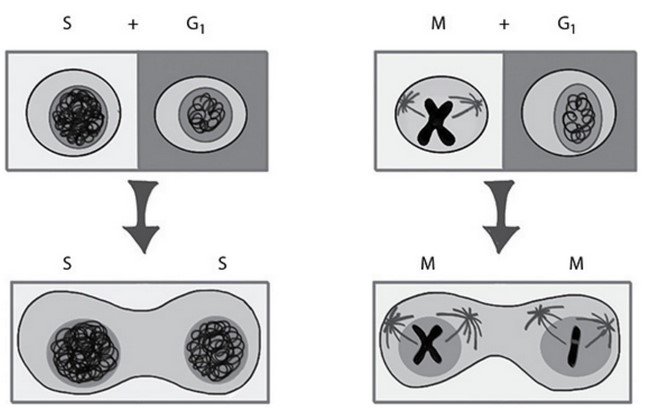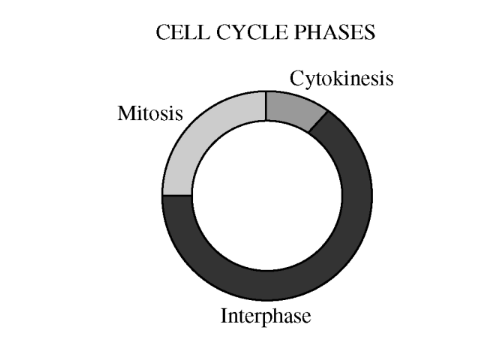Question
A student wants to test whether treating onion root cells with caffeine will significantly increase the number of cells in mitosis. Two groups
of onions are grown: one group received distilled water, and the other received distilled water with caffeine. The root tips of both groups are
harvested and stained, and the number of cells in interphase and mitosis in each group is counted. The expected and observed data are
shown in the following table.
(a) State the null hypothesis for this experiment.
(b) Identify the independent variable and the dependent variable.
(c) Use the chi-square equation and a p-value of 0.05 to analyze the
data. Determine if there is a statistically significant difference
between the two groups of onions.
(d) Justify your conclusion from part (c).
▶️Answer/Explanation
Ans:
(a) The null hypothesis is that there is no statistically significant
difference between the number of cells in interphase and the
number of cells in mitosis in the untreated cells compared to the
number of cells in interphase and the number of cells in mitosis in
the cells treated with caffeine.
(b) The independent variable is the presence of caffeine. The
dependent variable is the number of cells in interphase or mitosis.
(c) Chi-square = \(x^2 = \Sigma \frac{(observed-expected)^2}{expected}\)
Chi-square \(=\frac{(175-156)^2}{156}+\frac{(50-69)^2}{69}+\frac{(150-169)^2}{169}+\frac{(95-76)^2}{76}\)
Chi-square = 2.314 + 5.232 + 2.136 + 4.750
Chi-square = 14.432
There are four possible outcomes to the experiment, so there are
3 degrees of freedom (df = number of possible outcomes – 1).
Using a p-value of 0.05, the critical value from the chi-square
table is 7.81. Based on these calculations, there is likely a
statistically significant difference between the two groups of
onions.
(d) Since the calculated chi-square value of 14.432 is greater than the
critical value of 7.81, the null hypothesis is rejected, and it is
possible to say there is likely a statistically significant difference
between the treated and untreated groups. The data support the
alternative hypothesis that the addition of caffeine increases the
mitotic rate in onion root cells.
Question
Cells in the S phase (synthesis, the second stage of interphase when DNA replication occurs) of the cell cycle were fused to cells in the \(G_1\) phase (\(gap_1\), the first stage of interphase). A group of cells in the M phase (mitotic phase, during the separation of the duplicated chromosomes) were fused to cells in the \(G_1\) phase. The results are shown as follows.

Explain the results of the experiment. State a hypothesis that was tested.
▶️Answer/Explanation
Ans:
Fusing the cells combines their cytoplasms. In the cell cycle, S phase follows the \(G_1\) phase, so the fusion of S phase cells and \(G_1\) phase cells indicates that the \(G_1\) nucleus was triggered to begin DNA replication by something in the S cell cytoplasm. The fusion of M cells with \(G_1\) cells also triggers mitosis in \(G_1\) cells despite the fact that DNA replication had not yet occurred.
The hypothesis: Cytoplasmic factors induce later stages in the cell cycle
to occur.
You do not have to know any particular growth factor or cyclin-CdK pair that
regulates the cell cycle.
Question

Human cells divide every day for normal growth, replacement of cells, and tissue repair. The dividing cells proceed through the three phases of the cell cycle as shown in the figure. When a person experiences a cut, damaged skin cells secrete a protein called epidermal growth factor (EGF). Epidermal (skin) cells in the vicinity of the injury possess proteins in their cell membranes called epidermal growth factor receptors (EGFR)
(a) Identify the THREE major stages of interphase, and describe the sequence in which they occur.
(b) Describe the most likely role of EGF and the role of EGFR in a cell signaling pathway. Describe how the cellular response to EGF results in tissue repair.
(c) Cancer can result from disruptions in cell cycle control. Mutations that increase the production of EGFR have been associated with skin cancer of the head and neck. Describe how a mutation outside of the coding region of a gene that encodes EGFR could lead to the overproduction of EGFR protein in a skin cell.
(d) In cases of skin cancer that are associated with overproduction of EGFR, treatment with antibodies against the extracellular portion of EGFR has been successful. Propose a model to explain how the antibody therapy most likely interferes with the cell signaling pathway, and give ONE reason the therapy is effective for treating cancer.
▶️Answer/Explanation
(a) Identify the THREE major stages of interphase, and describe the sequence in which they occur
(a) Identification
•Growth/G1
•DNA Synthesis/S
•Preparation for mitosis/G2
Description
•Growth, DNA synthesis, preparation for mitosis/G1, S, G2
(b) Describe the most likely role of EGF and the role of EGFR in a cell signaling pathway. Describe how the cellular response to EGF results in tissue repair.
(b) Description
•EGF is a ligand/binds to EGFR/activates the receptor
•Activated receptor (EGFR) initiates cell signaling pathway/internal signaling cascade
•Cellular response initiates cell cycle progression/cell division
(c) Cancer can result from disruptions in cell cycle control. Mutations that increase the production of EGFR have been associated with skin cancer of the head and neck. Describe how a mutation
outside of the coding region of a gene that encodes EGFR could lead to the overproduction of EGFR protein in a skin cell.
(c)Description
•Mutation in regulatory sequence (promoter or enhancer) could increase rate of transcription of EGFR gene
•Mutation in transcription factor could increase production of mRNA, which would lead to production of more polypeptide
•Gene duplication may increase production of EGFR
•Gene translocation may inactivate repressor
•Mutation in repressor gene may remove controls on cell division
•Change in mRNA sequence may increase translation efficiency or mRNA stability
(d) In cases of skin cancer that are associated with overproduction of EGFR, treatment with antibodies against the extracellular portion of EGFR has been successful. Propose a model to explain how the antibody therapy most likely interferes with the cell signaling pathway, and give ONE reason the therapy is effective for treating cancer
(d) Proposed model
•Antibody competes with/prevents ligand binding to EGFR
•Receptor activation is inhibited.
Reasoning
•Inhibits cell cycle progression
•Blocks cell division
